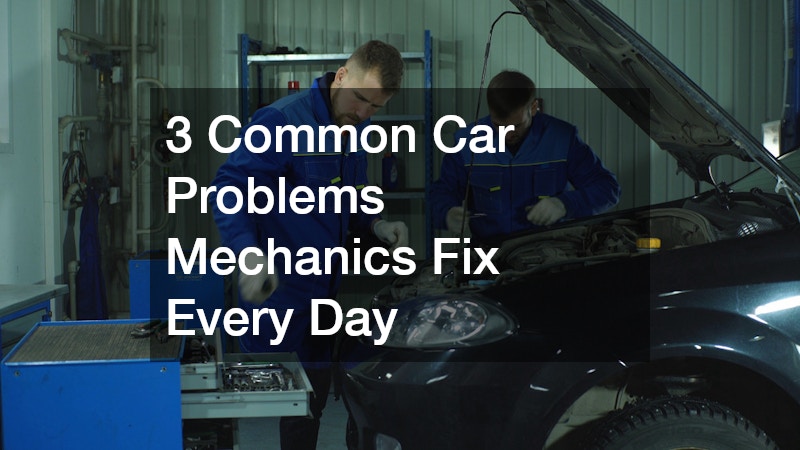
Mechanics play a crucial role in keeping vehicles safe, efficient and roadworthy. Every day, they work on a wide range of automotive issues from routine servicing to complex diagnostic problems.
With years of hands-on experience and specialised tools, they are trained to identify the root causes of vehicle troubles and provide effective solutions that keep cars running smoothly.
For most car owners, a visit to the mechanic is inevitable at some point. Even the most reliable vehicles experience wear and tear over time. By understanding which problems occur most frequently, drivers can take proactive steps to maintain their vehicles and avoid unexpected breakdowns. Here are three common car problems that mechanics fix every day.
1. Engine Warning Lights and Diagnostics
One of the most frequent reasons people book a visit to a mechanic is the sudden appearance of a warning light on the dashboard. Among the most alarming is the check engine light, which can signal anything from a loose petrol cap to serious engine trouble. Although the warning light itself does not provide specific details, it indicates that the onboard diagnostics system has detected a fault.
Mechanics use diagnostic tools to scan the vehicle’s computer and retrieve error codes. These codes help pinpoint the nature and location of the problem. Some common issues behind a check engine light include faulty oxygen sensors, engine misfires, emissions faults and fuel system irregularities.
Ignoring the warning signs can lead to greater damage over time. For instance, a small sensor failure might increase fuel consumption or cause excess wear on engine components. Mechanics address the issue early to prevent further complications. They may replace a faulty part, update software or carry out more detailed testing to ensure the vehicle is operating within manufacturer specifications.
Beyond the check engine light, other dashboard symbols also require prompt attention. These can include oil pressure warnings, temperature alerts and electronic stability control notices. Mechanics are trained to interpret these signals and perform the necessary work to return the vehicle to safe operation.
2. Brake System Repairs and Maintenance
The braking system is one of the most important safety components in any vehicle. Problems with brakes are common and something that mechanics deal with every day. Drivers often report squealing noises, grinding sounds, vibrations when braking or a spongy brake pedal. Some vehicles may also display a brake warning light, signalling low fluid or worn pads.
Mechanics conduct thorough inspections of the braking system, checking pads, discs, callipers and hydraulic lines. Brake pads are among the most frequently replaced parts in automotive workshops. They wear down over time and need to be changed before they become too thin to function effectively. Worn-out pads can lead to reduced stopping power and damage to brake discs, which can be more expensive to replace.
Other common issues include warped rotors, leaking brake lines and contaminated brake fluid. In some cases, brake callipers may seize due to corrosion or debris, causing uneven braking. Mechanics perform tests to measure braking efficiency and recommend repairs based on the condition of the system.
Regular brake maintenance is essential to ensure driver and passenger safety. Professional mechanics can also upgrade the braking system for improved performance, particularly in high-use or heavy-duty vehicles.
3. Battery and Starting System Failures
Another widespread problem handled by mechanics daily is battery failure and starting system faults. A flat or dead battery is one of the leading causes of roadside breakdowns, especially during colder months or after long periods of inactivity. While many people attempt to jump-start the car themselves, this is often a temporary fix.
Mechanics test the battery’s voltage, cold cranking amps and charge retention. They also check the alternator and starter motor to ensure the charging system is functioning properly. Sometimes, the battery is in good condition, but the problem lies with corroded terminals, loose cables or a faulty ignition switch.
If the battery is aged or unable to hold a charge, mechanics will replace it with a suitable model for the vehicle. They also take steps to ensure the new battery is installed correctly and registered with the vehicle’s onboard systems, particularly in modern cars with advanced electronics.
Starting system issues may also involve relay faults, immobiliser malfunctions or wiring problems. Mechanics use multimeters and other diagnostic tools to trace electrical faults and restore proper function.
Battery maintenance is often overlooked until the vehicle fails to start. Routine servicing includes battery inspections and cleaning of terminals, which helps extend the battery’s life and reduces the chance of failure at inconvenient times.
While countless vehicle problems can arise, some are far more common than others. Engine warning lights, brake issues and battery faults are three of the most frequent problems mechanics deal with every day. These issues not only affect the safety and reliability of a vehicle but can also lead to higher repair costs if left unchecked.
By visiting a trusted mechanic at the first sign of trouble, drivers can address problems early, minimise damage and keep their cars in optimal condition. Regular maintenance and inspections are key to preventing unexpected breakdowns and ensuring long-term performance.
Mechanics are trained to handle these common issues efficiently, using industry-standard equipment and parts. Their expertise ensures that vehicles meet road safety regulations and perform reliably under all driving conditions. Whether it’s a simple brake pad replacement or a complex engine diagnostic, professional mechanics keep Australia’s roads safe one repair at a time.



